Trip: Corbett Tiger Reserve
Camp: Sultan FRH (2 nights), Gairal FRH (1 night)
Dates: 1 Apr – 6 Apr ‘15
Who: VV, KB and my seven year old son
 This is going to be another long post. I guess it is deserved, considering that this was the best wildlife trip I’ve ever done, in terms of sheer sighting productivity.
This is going to be another long post. I guess it is deserved, considering that this was the best wildlife trip I’ve ever done, in terms of sheer sighting productivity.
VV and I had planned this trip well in advance and we were eager to get bookings at the famed Dhikala FRH. And VV had coordinated with Pavan Puri to put this trip together. Despite three people being poised to click exactly when booking opened 45 days in advance, we could not get Dhikala and had to be content with Sultan for the first two nights and Gairal for the third. I was contemplating canceling the trip and retrying our luck with Dhikala, but VV persuaded me to stick with the plan. The experience turned out to be completely unexpected (at least as far as we were concerned).
Dhikala was big and crowded, though there was the apparent advantage of being right where the sightings were (and thereby allowing guests to hang around the chaur until lockdown time at 6:30 PM, unlike guests staying at Sarapduli, Gairal, Sultan or one of the other places who needed to leave at 5 PM or whenever to reach their lodgings before 6:30 PM). Despite this, I would not like to stay at Dhikala when I go back. Sultan is the place to stay at.
Sultan was spectacular, nestling amidst a lovely stand of Sal, with just two rooms and no electric fencing (or electricity for that matter). The moon was nearly full at this time and the forest was expectedly ethereal in the moonlight. Chital alarm calls were heard around the FRH after dark. In addition to the persistent calls of nightjar – possibly Grey or Large-tailed – and of the Brown hawk owl.
Gairal FRH is much larger with nine rooms. It overlooks the Ramganga, but there is not much point to this as access to the river is cut off by electric fencing. Again not a patch on Sultan, in my admittedly dubious opinion.
This trip was restricted to the Dhikala safari zone. VV pointed out that the Bijrani safari zone was also worth exploration, and our quiet but competent driver Harish Patwal added that the Malani FRH there was a fair equivalent of Sultan. So those are the places I’ll head to the next time.
The weather at this time of year was interesting. It rained quite a bit. Mornings and evenings were cold while the rest of the day was hot. Nights were cool enough to sleep pleasantly through despite the absence of fans.
Corbett has a unique arrangement in terms of timings. Vehicles are allowed to leave the FRHs at 6 AM and have to be back by 6:30 PM. There is a lock-down in effect between 11 AM and 2:30 PM. All visitors have to be confined to one of the camps, or to one of the two watchtowers around Dhikala during this slot. We spent two of the four days on one of the watchtowers near Dhikala (the one near Sambar road I think) during the lockdown hours. The other two we spent doing lazy lunches at Dhikala and Gairal.
In terms of itinerary, we had initially planned to fly to Delhi and take the overnight train from there to Ramnagar. After some consideration, we changed our minds, advanced our air tickets to reach Delhi by 3 PM, and covered the 250 kms to Ramnagar by road, reaching there at 11:30 PM thanks to peak-time traffic in Delhi. On the way back, we took the train to Delhi and then took the morning flights out.
Some distances. The Dhangari gate is the gateway into the Dhikala safari zone and this is 18 kms from Ramnagar. Unless I got this wrong, Sultan is 6 kms from this gate, Gairal 15, and Dhikala 31 kms away.
Flora  I spent quite some effort in identifying commonly seen trees and plants on this trip. It was a useful way to keep engaged whilst on the drive and between bird or mammal sightings. Time I’d otherwise have squandered away dreaming.
I spent quite some effort in identifying commonly seen trees and plants on this trip. It was a useful way to keep engaged whilst on the drive and between bird or mammal sightings. Time I’d otherwise have squandered away dreaming.
The landscape of Corbett TR is dominated by the Sal tree (Shorea robusta) to the extent of 73%. At this time of year, the trees were flowering and entire hillsides appeared dusted over with greenish white powder, contrasting with the dark green of the ribbed leaves below.  The Sal trees were also shedding heavily and the ground in many places was carpeted with rotting leaf litter.
The Sal trees were also shedding heavily and the ground in many places was carpeted with rotting leaf litter.  In some stands of Sal, Rohini (Mallotus phillipinensis) grew in profusion in the understory. This is a diminutive tree bearing clusters of small, red fruit that find use in producing red dye and sindoor. The very picturesque last kilometer of road before Dhikala was reached boasted of plenty of these trees.
In some stands of Sal, Rohini (Mallotus phillipinensis) grew in profusion in the understory. This is a diminutive tree bearing clusters of small, red fruit that find use in producing red dye and sindoor. The very picturesque last kilometer of road before Dhikala was reached boasted of plenty of these trees. 
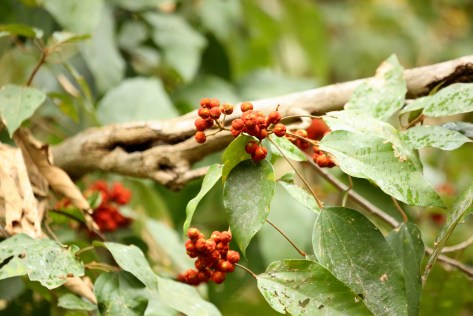 Terminalia elliptica, our Kari Mathi, was fairly common too. And I could occasionally spot Axlewood (Anogeissus latifolia). In some places, particularly around Dhikala, Indian gooseberry (Phyllanthus emblica) occurred.
Terminalia elliptica, our Kari Mathi, was fairly common too. And I could occasionally spot Axlewood (Anogeissus latifolia). In some places, particularly around Dhikala, Indian gooseberry (Phyllanthus emblica) occurred.
In several areas, Haldu (Haldina cordifolia) grew in profusion, with many specimens having attained impressive girths.  Alongside the Ramganga, Jamun (Syzygium cumini) was occasionally seen.
Alongside the Ramganga, Jamun (Syzygium cumini) was occasionally seen.  The Kusum tree (Schleichera oleosa) stood out at this time of year as its newly sprouted leaves were red in colour, the contrast rendering it rather pretty.
The Kusum tree (Schleichera oleosa) stood out at this time of year as its newly sprouted leaves were red in colour, the contrast rendering it rather pretty.  At one of the stream crossings, Harish pointed out a few specimens of Chir pine (Pinus roxburghii). This is the lone coniferous species that occurs in Corbett.
At one of the stream crossings, Harish pointed out a few specimens of Chir pine (Pinus roxburghii). This is the lone coniferous species that occurs in Corbett.  In terms of plants, the understory in the Sal forests was dominated by two species for most part – Hill glorybower (Clerodendrum infortunatum) and Lantana camara. Both were flowering in profusion, the former decked out in little, five-petaled white flowers, each sprouting four tendrilly stamens. And the latter blossoming in a riot of white, orange, yellow and violet.
In terms of plants, the understory in the Sal forests was dominated by two species for most part – Hill glorybower (Clerodendrum infortunatum) and Lantana camara. Both were flowering in profusion, the former decked out in little, five-petaled white flowers, each sprouting four tendrilly stamens. And the latter blossoming in a riot of white, orange, yellow and violet.
Clerodendrum infortunatum: 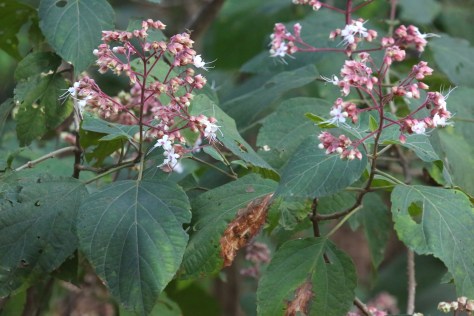 The many hues of Lantana camara:
The many hues of Lantana camara:  Ageratum conyzoides, another exotic locally known as baansila also bore little white flowers and was very common.
Ageratum conyzoides, another exotic locally known as baansila also bore little white flowers and was very common. 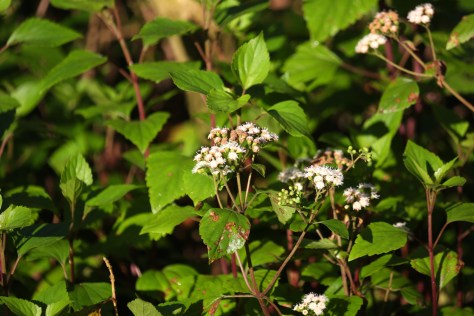 The Curry plant (Murraya koenigii) was seen in abundance, especially around Dhikala. The stretch of road known as Tunbhoji contains whole stretches of Curry plants.
The Curry plant (Murraya koenigii) was seen in abundance, especially around Dhikala. The stretch of road known as Tunbhoji contains whole stretches of Curry plants.  Colebrookea oppositifolia with its worm-like inflorescence was abundant in some places.
Colebrookea oppositifolia with its worm-like inflorescence was abundant in some places.  In many areas Cannabis, possibly Cannabis sativa covered the ground in profusion.
In many areas Cannabis, possibly Cannabis sativa covered the ground in profusion.  Ferns are commonly met with in the Sal forests. This one below is possibly Adiantum sp.
Ferns are commonly met with in the Sal forests. This one below is possibly Adiantum sp.  And this one is possibly Pteris sp.
And this one is possibly Pteris sp.  These four species I am yet to identify – all four were very common.
These four species I am yet to identify – all four were very common.
This plant is locally known as Tun. It is laden with clusters of green berries, some turning purple. A track around Dhikala (which connects with the famed Thandi sadak) is lined with this species and is called Tunbhoji.  This species of plant growing to around a foot in height packed the verges in many places. Harish identified it as Anjeer.
This species of plant growing to around a foot in height packed the verges in many places. Harish identified it as Anjeer.  Another plant very commonly seen, and most often in a tattered condition and sprouting buds. Perhaps it is Pogostemon amaranthoides, which is said to occur in Corbett TR.
Another plant very commonly seen, and most often in a tattered condition and sprouting buds. Perhaps it is Pogostemon amaranthoides, which is said to occur in Corbett TR. 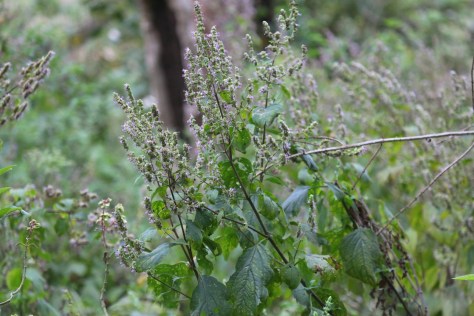 This is a very common concomitant of Baansila – Ageratum conyzoides. It has little lavender flowers which are similar to those of Ageratum. Harish maintained that it was another variant of the same species, but that is quite evidently not the case. The plant itself is much smaller, and so are the leaves. They are reminiscent of mint leaves. The specimen in this picture below has been drenched in rain.
This is a very common concomitant of Baansila – Ageratum conyzoides. It has little lavender flowers which are similar to those of Ageratum. Harish maintained that it was another variant of the same species, but that is quite evidently not the case. The plant itself is much smaller, and so are the leaves. They are reminiscent of mint leaves. The specimen in this picture below has been drenched in rain.  Birding It would be an understatement to say that birding in Corbett is breathtaking. Most wildlife spots boast of somewhere under 300 bird species in my experience. Corbett boasts of 600. Unless this claim is inflated. I exceeded a species count of 100 for the very first time, with around 30 lifers thrown in. And this despite the fact that we were not exactly birding with a vengeance – we let a bunch of sightings go unidentified. It did help that that VV was fairly expert at the local avifauna.
Birding It would be an understatement to say that birding in Corbett is breathtaking. Most wildlife spots boast of somewhere under 300 bird species in my experience. Corbett boasts of 600. Unless this claim is inflated. I exceeded a species count of 100 for the very first time, with around 30 lifers thrown in. And this despite the fact that we were not exactly birding with a vengeance – we let a bunch of sightings go unidentified. It did help that that VV was fairly expert at the local avifauna.
The calls of Black-hooded oriole, Red-breasted parakeet, Plum-headed parakeet, Common hawk cuckoo and Spotted dove were the typical sounds heard. We encountered the Blue whistling thrush and that most remarkable bird, the White-crested laughing thrush several times along the forest roads.  Kalij pheasants gave us a couple of close and very patient photo ops, unlike their cousins the Red junglefowl which were considerably more nervous.
Kalij pheasants gave us a couple of close and very patient photo ops, unlike their cousins the Red junglefowl which were considerably more nervous. 

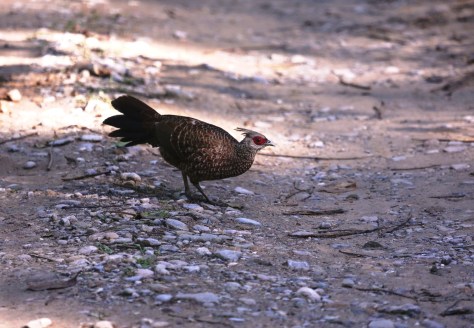 A Great Indian hornbill swished past on our last day there. I finally managed to sight a bird that I’ve heard many times but have never managed to see – the Indian cuckoo. I also had the considerable satisfaction of spotting and later identifying the spectacular colours of the Rufous-bellied niltava. We spent many engrossing minutes from the Dhikala watchtower peeping on a pair of mating parakeets.
A Great Indian hornbill swished past on our last day there. I finally managed to sight a bird that I’ve heard many times but have never managed to see – the Indian cuckoo. I also had the considerable satisfaction of spotting and later identifying the spectacular colours of the Rufous-bellied niltava. We spent many engrossing minutes from the Dhikala watchtower peeping on a pair of mating parakeets.
Red turtle doves frequent the Dhikala camp in large numbers, and were rarely encountered elsewhere. 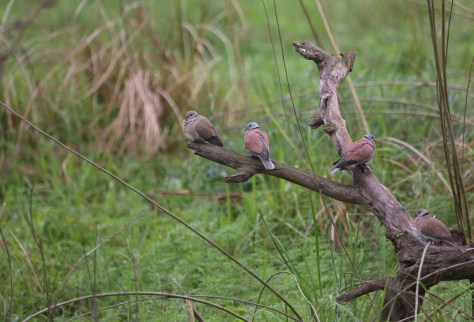 Corbett is a raptor-watcher’s paradise. Pallas’s fish eagle and Lesser fish eagle were commonly encountered. As were CSE, CHE and a host of vultures.Common kestrel and Shikra were also frequently seen.
Corbett is a raptor-watcher’s paradise. Pallas’s fish eagle and Lesser fish eagle were commonly encountered. As were CSE, CHE and a host of vultures.Common kestrel and Shikra were also frequently seen.
Brown fish owl:  On the chaurs, Paddyfield pipit, Pied bushchat and Common stonechat ruled. With some drongos thrown in for good measure. River lapwings and River terns were commonly seen along the water’s edge.
On the chaurs, Paddyfield pipit, Pied bushchat and Common stonechat ruled. With some drongos thrown in for good measure. River lapwings and River terns were commonly seen along the water’s edge. 
Mammals and reptiles
Sambar hind by the eponymous Sambar road.  Sambar hind and fawn fording the Ramganga; photographed from the Dhikala watchtower.
Sambar hind and fawn fording the Ramganga; photographed from the Dhikala watchtower. 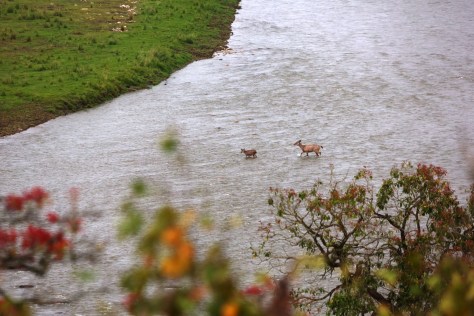 Wild boar at Dhikala.
Wild boar at Dhikala.  Hog deer hind by the Ramganga reservoir.
Hog deer hind by the Ramganga reservoir. 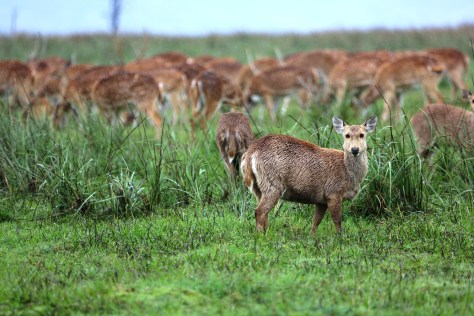
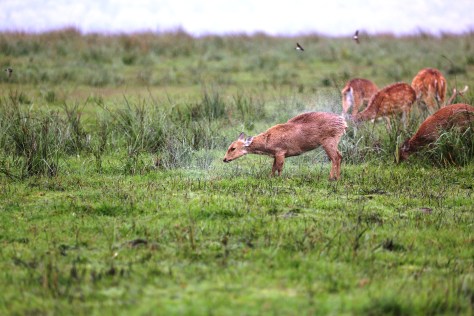 Multiple herds of elephants were invariably at the Ramganga reservoir each evening.
Multiple herds of elephants were invariably at the Ramganga reservoir each evening. 
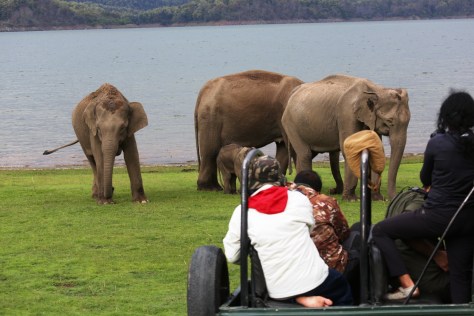
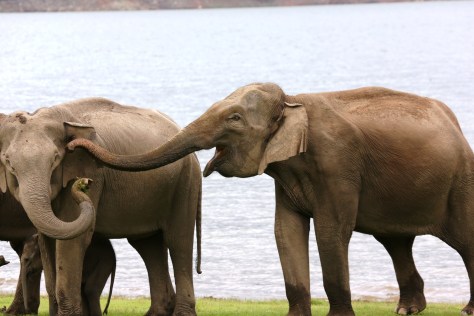
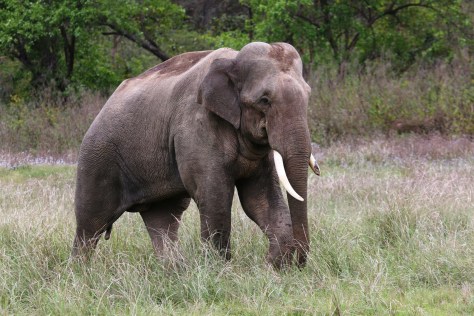 We saw this crippled calf and its herd on a couple of occasions. The mother’s handling of its inability to keep up was an object lesson in forbearance.
We saw this crippled calf and its herd on a couple of occasions. The mother’s handling of its inability to keep up was an object lesson in forbearance. 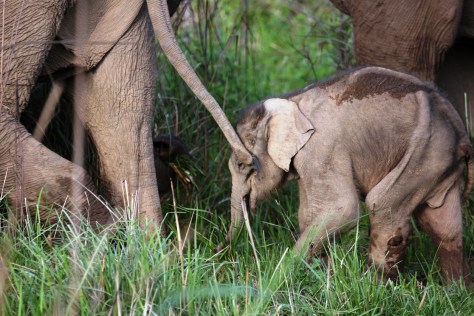 We invariably encountered jackal pairs in the picturesque stretch of Sal forest just before reaching Dhikala, and in the chaur around it. Here, doing it just like a dog.
We invariably encountered jackal pairs in the picturesque stretch of Sal forest just before reaching Dhikala, and in the chaur around it. Here, doing it just like a dog. 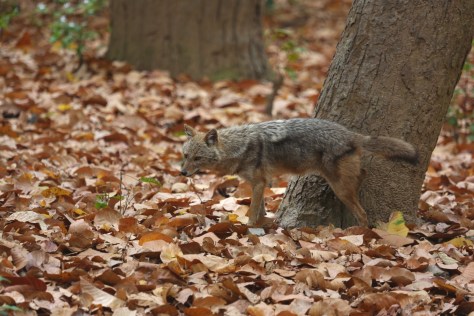 This python was stationed near Gorkha sot and sighted by most passing jeeps. It was most probably an Indian python, but could have been a Burmese python too. Yawning, in the second picture.
This python was stationed near Gorkha sot and sighted by most passing jeeps. It was most probably an Indian python, but could have been a Burmese python too. Yawning, in the second picture. 
 At the point where a road branches off to the Khinnanauli FRH, we saw a pair of Yellow-throated marten dart across the road. The pair presently returned and recrossed again. This creature was on my wishlist for the trip. Harish noted that they were often seen in the vicinity. The weather was wet and presently the skies opened up. We waited a while longer before giving up. We then took to referring to the junction as ‘Marten point’ and looked for the pair each time we passed thereafter, with no luck however.
At the point where a road branches off to the Khinnanauli FRH, we saw a pair of Yellow-throated marten dart across the road. The pair presently returned and recrossed again. This creature was on my wishlist for the trip. Harish noted that they were often seen in the vicinity. The weather was wet and presently the skies opened up. We waited a while longer before giving up. We then took to referring to the junction as ‘Marten point’ and looked for the pair each time we passed thereafter, with no luck however.
On day 3, we were rushing back to Gairal at sunset, being late for the 6:30 deadline. The light was rapidly fading. When we reached crocodile point, Harish slammed the brakes exclaiming “Tiger!”. Sure enough, a male got up and off the road, and wandered over into the bushes to our left (the viewpoint was to our left too, the tiger was in the bushes just past the viewpoint). Resenting our intrusion, the cat set up a series of growls while blundering through the thick undergrowth. I suggested that we pull into the viewpoint to peep over the bushes he was in, but Harish felt the tiger would charge if provoked. In a few minutes, realizing we weren’t being driven away by the growling, the tiger re-emerged onto the road, crossed it, and stood on the verge for a minute staring fixedly at us, before disappearing into the undergrowth. Junior incidentally dived under his seat and stayed hidden there through the growling.
Here’s a picture I hurriedly clicked at an ISO of 25,600 in the failing light. 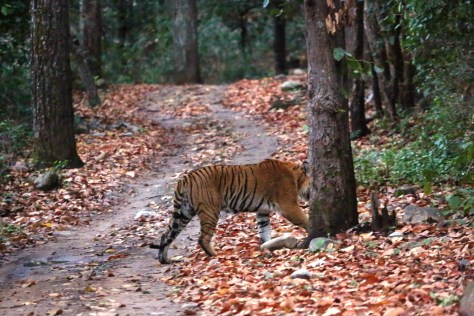
Incidentally, Corbett doesn’t seem to be very big on naming individual tigers. However this particular male went by the moniker of Diwani Ram ka tiger, named after a fire watcher he killed three years back.
Our second tiger sighting happened the next morning. Alarm calls were reported from the stand of burnt trees near the reservoir. A tigress had evidently been spotted disappearing into the thickets by someone and the local phone tree was burning up. We reached there to join some eight or ten other Gypsies all lined up in the blazing sun on the chaur. A very large herd of chital grazed placidly nearby.
We’d just finishing admiring an osprey on a nearby tree when out of the thickets came the tigress, charging straight into the herd. She missed bagging anything and lost the advantage of surprise. The deer however went into milling confusion presenting another opportunity. She then made a second attempt, which failed too. After which she retired to the thicket, closely followed by the entire chital herd in formation, anxious not to lose sight of her.
Here’s a part of the sequence. 

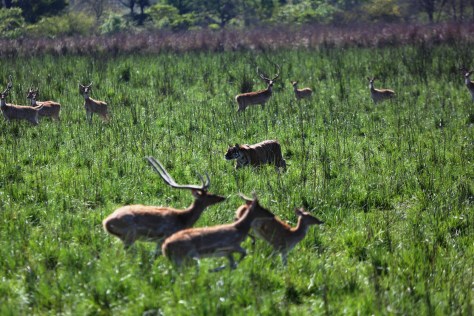





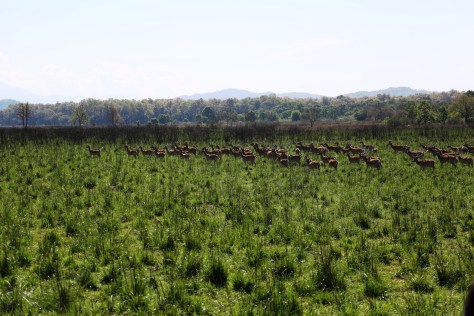
The list Birds:
- Ashy bulbul
- Ashy-crowned sparrow lark
- Ashy drongo
- Ashy prinia
- Ashy woodswallow
- Asian paradise flycatcher
- Bar-headed goose
- Black-hooded oriole
- Black redstart
- Black stork
- Black-shouldered kite
- Black-winged stilt
- Blue-bearded bee-eater
- Blue-throated barbet
- Blue whistling-thrush
- Brown-capped pygmy woodpecker
- Brown fish owl
- Brown hawk owl (calls)
- Changeable hawk eagle
- Chestnut-tailed starling
- Cinereous tit
- Cinereous vulture?
- Yellow wagtail
- Collared falonet
- Common green magpie (calls)
- Common hawk cuckoo
- Common iora
- Common kestrel
- Common myna
- Common sandpiper
- Common stonechat
- Coppersmith barbet
- Cormorant (?)
- Crested kingfisher
- Crested serpent eagle
- Egret (?)
- Eurasian collared dove
- Eurasian or Himalayan cuckoo (?)
- Fulvous woodpecker
- Gold-fronted leaf bird
- Great Indian hornbill
- Great slaty woodpecker
- Green bee-eater
- Grey-capped pygmy woodpecker
- Grey-headed fish eagle
- Grey-headed woodpecker
- Grey heron
- Grey wagtail
- Hen harrier?
- Himalayan bulbul
- Indian cuckoo?
- Indian grey hornbill
- Indian spotted eagle?
- Indian treepie
- Jungle babbler
- Jungle myna
- Kalij pheasant
- Large cuckooshrike
- Lesser fish eagle
- Lesser flameback
- Lesser yellownape
- Lineated barbet
- Long-tailed nightjar, or possibly Grey nightjar (calls)
- Long-tailed shrike
- Magpie robin
- Orange-headed thrush
- Orange minivet
- Oriental honey buzzard
- Oriental pied hornbill
- Oriental skylark?
- Oriental white-eye
- Osprey
- Paddyfield pipit
- Pallas’s fish eagle
- Peafowl
- Pied bushchat
- Pied kingfisher
- Plum-headed parakeet
- Purple sunbird
- Red avadavat
- Red-breasted parakeet
- Red-headed vulture
- Red junglefowl
- Red turtle dove/Red collared dove
- Red-vented bulbul
- Red-wattled lapwing
- Red-whiskered bulbul
- River lapwing
- River tern
- Rock dove/Blue rock pigeon
- Rose-ringed parakeet
- Rosy minivet
- Rosy starling
- Rufous-bellied niltava
- Ruddy shelduck
- Shikra
- Small minivet
- Spangled drongo
- Spotted dove
- Streak-throated woodpecker
- Striated grassbird?
- Striated laughingthrush
- Tailor bird (calls)
- Tawny fish owl
- Velvet-fronted nuthatch
- Warbler (?)
- White-browed wagtail
- White-crested laughingthrush
- White-eyed buzzard
- White-rumped vulture?
- White-throated kingfisher
- White-throated laughingthrush
- White wagtail
- Wooly-necked stork
- Yellow-eyed babbler
- Yellow-footed green pigeon
Mammals:
- Barking deer
- Chital
- Common langur
- Common mongoose
- Elephant
- Hog deer
- Rhesus macaque
- Sambar
- Tiger
- Wild boar
- Yellow-throated marten
Reptiles:
- Bengal monitor
- Gharial
- Indian or Burmese python
- Mugger
Woww.. D & I were admiring the pics..they are beautiful. Love the shots of the forest and one of the Ramganga reservoir with a sole elephant. Btw, almost fell off my chair after seeing the # of birds listed !
Thanks Koel. It was a lovely place indeed. And the birding was incredible, yes.
‘Awesome it is!’ as P describes it 🙂 Didn’t realised we’d seen so much on this trip. And thanks for proving your inputs on the plants/ trees of Corbett. Overall this blog is very informative even as a ready reckoner for someone’s next trip.
Thanks Vidya. And thanks for the excellent birding experience. We’ve now raised the bar for Sunderbans.
Hey, This is great and Sunderbans will be different so dont raise the bar :),
Ha ha, you are our lucky charm now, Kedar. Ups the expectations for the Sunderbans now.
Super rich experience Badri!! Well done
Thank you Madhavi.
Stumbled on researching some pics abt wild… good write up . where are u from ? may be i can join u!!
Good write up !! was checking for some reviews and got this !! where are u from ? may b i can join u !!
Good write up !! was checking for some reviews and got this !! where are u from ? may b i can join u !!!
Thank you Rajesh!
Lovely experience, and beautiful documentation.
ramjee
P.S
Can you please share your e-mail would need your permission to use couple of images for my office work.
Thank you Ramjee. Badrikrish@lycos.com
Great to read.
Thanks Karan!